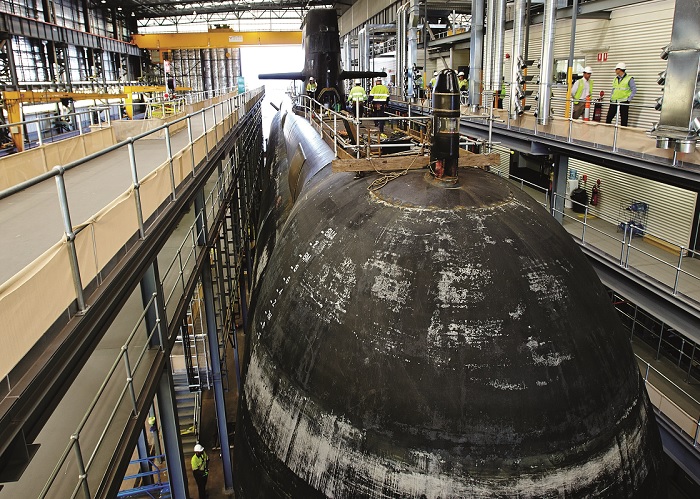
The transition from the Collins-class submarines to the future submarine fleet will be longer and more complex than any previous capability transition the Department of Defence has undertaken. Today ASPI released a special report, Thinking through submarine transition, which examines the key risks on this journey and recommends ways to address them.
The submarine enterprise will be in constant transition, rather than a short, bounded process. Traditional distinctions between design and build, between upgrade and sustainment, and indeed between different classes of vessel won’t be as absolute as they once were, requiring Defence and its industry partners to think differently. They’ll need to address challenging risks to prevent a decline in submarine capability and, ultimately, grow the submarine force and supporting enterprise. Overall, Australia’s submarine capability must be treated as a single enterprise, not two distinct fleets.
Even if the government tries to get out of the Collins business as soon as possible, it will still need to extend at least three Collins submarines and operate them to around 2042 to prevent a capability gap. However, that approach wouldn’t provide a greater number of submarines until around 2044.
Extending all six Collins would provide more submarines from 2032 and also help to mitigate one of the key challenges in the transition: the development of a much larger number of submariners. Under this option, the last Collins would be in service until around 2048, and it would be 45 years old. Regardless of which option the government chooses, it’s likely that some Collins boats aren’t even halfway through their service lives, and some members of the last Collins-class crew haven’t yet been born.
There doesn’t appear to be any way to achieve a fleet of 12 submarines before roughly 2054 without breaking out of the two-year future submarine production drumbeat. Doing so would require even greater spending on submarine construction and disrupt the continuous build cycle that the government is committed to.
At least three, and probably more, Collins boats will need to undergo ‘life of type’ extensions and serve for at least another 20 years, so maintaining ASC’s ability to sustain and upgrade them is essential to a successful transition. If ASC can’t preserve its Collins sustainment workforce, there will be a capability gap.
One way to preserve ASC’s viability is to decide now that it will also be the sustainment entity for the future submarine. That will allow it to balance the workforce between the Collins and the future submarine as well as provide its current workforce with career certainty and development as part of a planned transition from one fleet to the other. It will also help to ensure sovereign sustainment of Australia’s submarine capability.
However, to provide ASC with the understanding necessary to sustain and upgrade the future submarine throughout its service life, it would be beneficial to bring ASC into the boat’s design and build process. One potential commercial model for this could be similar to that adopted by the government for the future frigate project, in this case with Naval Group taking on ASC’s submarine arm as a subsidiary that may revert to full government control at some point. This model, however, is not yet proven. Whichever way ASC is brought into the build, it will require careful negotiation.
Bringing ASC into the future submarine’s design and build process would also allow it to apply its considerable expertise in sustaining submarines under Australian conditions with Australian industry partners. That approach would also allow greater coordination between the upgrade and extension of the Collins and the design of the future submarine. Collins could serve as a testbed for potential future submarine systems—provided that didn’t reduce the capability or availability of the Collins.
Moving the Collins’ complex two-year maintenance procedures (known as full-cycle dockings) to Western Australia and then conducting future submarine dockings there could also address sustainment workforce risks. But a decision to shift such work will need to balance the short-term disruption against the longer term gain.
Growing the size of the submariner workforce is another key challenge. It will need to be much larger than it is now—potentially more than three times the size. Two measures can help to address this. One is to extend the life of all Collins boats, as the navy will need more boats to train more submariners. The Collins could become a dedicated training fleet as more future submarines enter service, meaning that the government wouldn’t need to invest as heavily in maintaining the Collins’ regional capability edge.
But the most important measure to grow the uniformed workforce will be to establish a submarine base on the east coast to provide access to Australia’s largest population centres. Without that, it’s very difficult to see how the navy could ever crew the future submarine fleet, rendering the massive investment in the vessels nugatory.
There are no clear, stand-out options for an east coast base and all viable locations are currently occupied. Therefore, the earlier a decision on a location is made, the more time Defence, industry and those members of the community who’ll be affected will have to prepare. We should also not assume that it will be the last future submarines delivered that go to the east. Because the point of having an east coast base is to recruit and retain the workforce, it may be necessary to access that labour source sooner rather than later and base either some Collins or early future submarines there.
The government has some hard decisions ahead, and they can’t be put off indefinitely.

